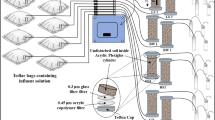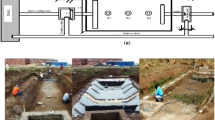Abstract
Three different flow regimes were carried out in a pilot-scale horizontal subsurface flow constructed wetland-treating sulfate rich wastewater contaminated with monochlorobenzene (MCB) and perchloroethene (PCE). The three regimes were continuous flow, 7-day cycle discontinuous flow, and 2.5-day cycle discontinuous flow. The results show that intensifying the tidal regime (2.5-day cycle) significantly enhanced MCB removal before 2 m from the inlet and increasing PCE removal efficiency at 0.5 m. The PCE dechlorination process was promoted with tidal operation, especially under the 2.5-day cycle regime, with significant increases of cis-1,2- dichloroethenes (DCEs), vinyl chloride (VC), and ethene, but trans-1,2-DCE was significantly decreased after tidal operation. Due to the high sulfate concentration in the influent, sulfide was observed in pore water up to 20 and 23 mg L−1 under continuous flow and 7-day cycle regime, respectively. However, sulfide concentrations decreased to less than 4 mg L−1 under intensified tidal operation (2.5-day cycle). The increase of oxygen concentration in pore water through intensified tidal operation resulted in better MCB removal performance and the successful inhibition of sulfate reduction. In conclusion, intensifying tidal operation is an effective approach for the treatment of chlorinated hydrocarbons and inhibiting sulfide accumulation in horizontal subsurface flow constructed wetland.







Similar content being viewed by others
References
Amon JP, Agrawal A, Shelley ML, Opperman BC, Enright MP, Clemmer ND, Slusser T, Lach J, Sobolewski T, Gruner W, Entingh AC (2007) Development of a wetland constructed for the treatment of groundwater contaminated by chlorinated ethenes. Ecol Eng 30:51–66
Austin, D., Lohan, E., Verson, E., Living machines I. Nitrification and denitrification in a tidal vertical flow wetland pilot. Published in Proceedings of the Water Environment Technical Conference 2003, Los Angeles, California, 2003.
Austin, D.C., Wolf, L., Strous, M., Mass transport and microbiological mechanisms of nitrification and denitrification in tidal flow constructed wetlands systems. In: Dias V, Vymazal J, editors. Proceedings of the 10th International Conference on Wetland Systems for Water Pollution Control, Ministerio de Ambiente, do Ordenamento do Territori e do Desenvolvimento Regional (MAOTDR) and IWA, September 23–29, 2006, Lisbon, Portugal, 2006, pp. 1147–1156.
Bankston JL, Sola DL, Komor AT, Dwyer DF (2002) Degradation of trichloroethylene in wetland microcosms containing broad-leaved cattail and eastern cottonwood. Water Res 36:1539–1546
Bradley PM (2003) History and ecology of chloroethene biodegradation: a review. Biorem J 7:81–109
Braeckevelt M, Rokadia H, Mirschel G, Weber S, Imfeld G, Stelzer N, Kuschk P, Kästner M, Richnow HH (2007a) Biodegradation of chlorobenzene in a constructed wetland treating contaminated groundwater. Water Sci Technol 56:57–62
Braeckevelt M, Mirschel G, Wiessner A, Rueckert M, Reiche N, Vogt C, Schultz A, Paschke H, Kuschk P, Kaestner M (2008) Treatment of chlorobenzene-contaminated groundwater in a pilot-scale constructed wetland. Ecol Eng 33:45–53
Braeckevelt M, Reiche N, Trapp S, Wiessner A, Paschke H, Kuschk P, Kaestner M (2011a) Chlorobenzene removal efficiencies and removal processes in a pilot-scale constructed wetland treating contaminated groundwater. Ecol Eng 37:903–913
Braeckevelt M, Seeger EM, Paschke H, Kuschk P, Kaestner M (2011b) Adaptation of a constructed wetland to simultaneous treatment of monochlorobenzene and perchloroethylene. Int J Phytorem 13:998–1013
Chan SY, Tsang YF, Chua H (2008) Domestic wastewater treatment using tidal-flow cinder bed with Cyperus alternifolius. Aquat Ecosyst Health 11:206–211
Chen Z, Wu S, Braeckevelt M, Paschke H, Kästner M, Köser H, Kuschk P (2012) Effect of vegetation in pilot-scale horizontal subsurface flow constructed wetlands treating sulphate rich groundwater contaminated with a low and high chlorinated hydrocarbon. Chemosphere 89:724–731
Cooper P (1999) A review of the design and performance of vertical-flow and hybrid reed bed treatment systems. Water Sci Technol 40:1–9
Cooper PF (2001) Nitrification and denitrification in hybrid constructed wetlands systems. In: Vymazal J (ed) Transformations of nutrients in natural and constructed wetlands. Backhuys Publishers, Leiden, The Netherlands, pp. 257–270
Field J, Sierra-Alvarez R (2008) Microbial degradation of chlorinated benzenes. Biodegradation 19:463–480
Garcia J, Rousseau DPL, Morato J, Lesage ELS, Matamoros V, Bayona JM (2010) Contaminant removal processes in subsurface-flow constructed wetlands: a review. Crit Rev Env Sci Tec 40:561–661
Green M, Friedler E, Ruskol Y, Safrai I (1997) Investigation of alternative method for nitrification in constructed wetlands. Water Sci Technol 35:63–70
Kassenga GR, Pardue JH, Blair S, Ferraro T (2003) Treatment of chlorinated volatile organic compounds in upflow wetland mesocosms. Ecol Eng 19:305–323
Kästner M, Fischer A, Nijenhuis I, Geyer R, Stelzer N, Bombach P, Tebbe CC, Richnow HH (2006) Assessment of microbial in situ activity in contaminated aquifers. Eng Life, Sci 6:234–251
Liu H, Hu Z, Zhang J, Ngo HH, Guo W, Liang S, Fan J, Lu S, Wu H (2016) Optimizations on supply and distribution of dissolved oxygen in constructed wetlands: a review. Bioresour Technol 214:797–805
Lv T, Wu S, Liu M, Ju X, Chang Y, Chen L, Dong R (2013) Comparison of purification performance in tidal flow and horizontal subsurface flow constructed wetlands. J Agro Environ Sci 32(8):1618–1624
MacLeod CJA, Reid BJ, Semple KT (1999) The fate of chlorinated organic pollutants in a reed-bed system. In: Leeson A, Alleman BC (eds) Phytoremediation and innovative strategies for specialized remedial applications: the Fifth International In Situ and On-Site Bioremediation Symposium. Batelle Press, Columbus (OH), USA, San Diego (CA)
Pardue JH, Kassenga G, Shin WS (1999) Design approaches for chlorinated VOC treatment wetland. In: Means JL, Hinchee RE (eds) Wetlands and remediation: an international conference. Batelle Press, Columbus (OH), USA, Salt Lake City, Utah, pp. 301–308
Stefanakis AI, Tsihrintzis VA (2009) Effect of outlet water level raising and effluent recirculation on removal efficiency of pilot-scale, horizontal subsurface flow constructed wetlands. Desalination 248:961–976
Sun G, Gray KR, Biddlestone AJ, Cooper DJ (1999a) Treatment of agricultural wastewater in a combined tidal flow-downflow reed bed system. Water Sci Technol 40:139–146
Sun G, Gray KR, Biddlestone AJ (1999b) Treatment of agricultural wastewater in a pilot-scale tidal flow reed bed system. Environ Technol 20:233–237
Sun G, Gray KR, Biddlestone AJ, Allen SJ, Cooper DJ (2003) Effect of effluent recirculation on the performance of a reed bed system treating agricultural wastewater. Process Biochem 39:351–357
Sun G, Zhao Y, Allen S (2005) Enhanced removal of organic matter and ammoniacal-nitrogen in a column experiment of tidal flow constructed wetland system. J Biotechnol 115:189–197
Sun GJ, Zhao Y, Allen S, Cooper D (2006) Generating “tide” in pilot-scale constructed wetlands to enhance agricultural wastewater treatment. Eng Life Sci 6:560–565
Tam NFY, Wong AHY, Wong MH, Wong YS (2009) Mass balance of nitrogen in constructed mangrove wetlands receiving ammonium-rich wastewater: effects of tidal regime and carbon supply. Ecol Eng 35:453–462
Vogt C, Alfreider A, Lorbeer H, Ahlheim J, Feist B, Boehme O, Weiss H, Babel W, Wuensche L (2002) Two pilot plant reactors designed for the in situ bioremediation of chlorobenzene-contaminated ground water: hydrogeological and chemical characteristics and bacterial consortia. Water, Air and Soil Pollution: Focus 2:161–170
Vymazal J (2009) The use constructed wetlands with horizontal sub-surface flow for various types of wastewater. Ecol Eng 35:1–17
Vymazal J, Masa M (2003) Horizontal sub-surface flow constructed wetland with pulsing water level. Water Sci Technol 48:143–148
Wu Y, Chung A, Tam NFY, Pi N, Wong MH (2008) Constructed mangrove wetland as secondary treatment system for municipal wastewater. Ecol Eng 34:137–146
Wu SB, Zhang DX, Austin D, Dong RJ, Pang CL (2011) Evaluation of a lab-scale tidal flow constructed wetland performance: oxygen transfer capacity, organic matter and ammonium removal. Ecol Eng 37(11):1789–1795
Wu S, Chen Z, Braeckevelt M, Seeger EM, Dong R, Kästner M, Paschke H, Hahn A, Kayser G, Kuschk P (2012) Dynamics of Fe (II), sulphur and phosphate in pilot-scale constructed wetlands treating a sulphate-rich chlorinated hydrocarbon contaminated groundwater. Water Res 46:1923–1932
Zhao YQ, Sun G, Lafferty C, Allen SJ (2004a) Optimising the performance of a lab-scale tidal flow reed bed system treating agricultural wastewater. Water Sci Technol 50:65–72
Zhao YQ, Sun G, Allen SJ (2004b) Purification capacity of a highly loaded laboratory scale tidal flow reed bed system with effluent recirculation. Sci Total Environ 330:1–8
Acknowledgments
This work was supported by the Fundamental Research Funds for the Central Universities (Program No. 2662015QC004), the International Science and Technology Cooperation Program from Hubei Province of China (Grant No. 2015BHE010), and the Helmholtz Centre for Environmental Research—UFZ within the scope of the SAFIRA II Research. We gratefully acknowledge Dr. John M. Marton and Dr. Paul Cooper for language correction.
Author information
Authors and Affiliations
Corresponding author
Additional information
Responsible editor: Philippe Garrigues
Rights and permissions
About this article
Cite this article
Chen, Z., Vymazal, J. & Kuschk, P. Effects of tidal operation on pilot-scale horizontal subsurface flow constructed wetland treating sulfate rich wastewater contaminated by chlorinated hydrocarbons. Environ Sci Pollut Res 24, 1042–1050 (2017). https://doi.org/10.1007/s11356-016-7871-y
Received:
Accepted:
Published:
Issue Date:
DOI: https://doi.org/10.1007/s11356-016-7871-y




